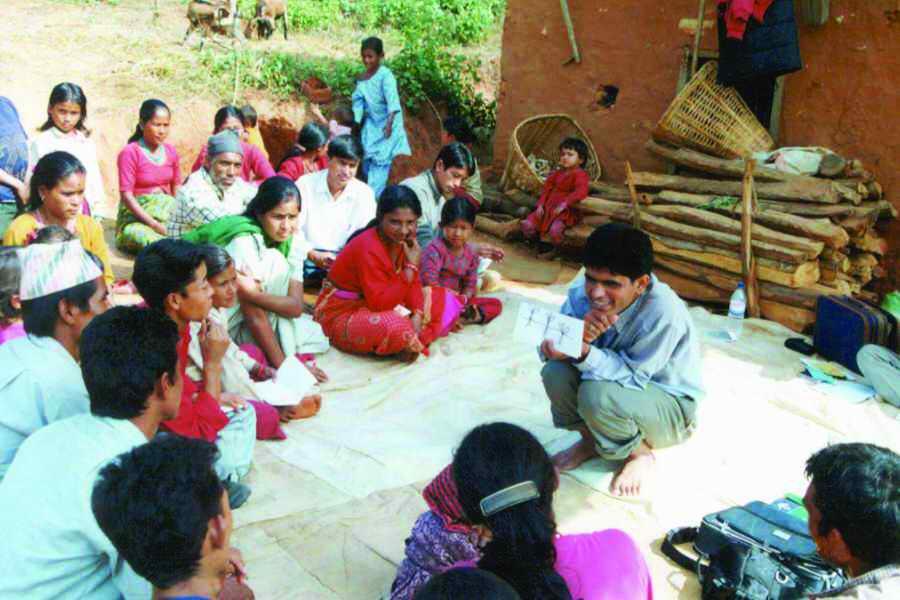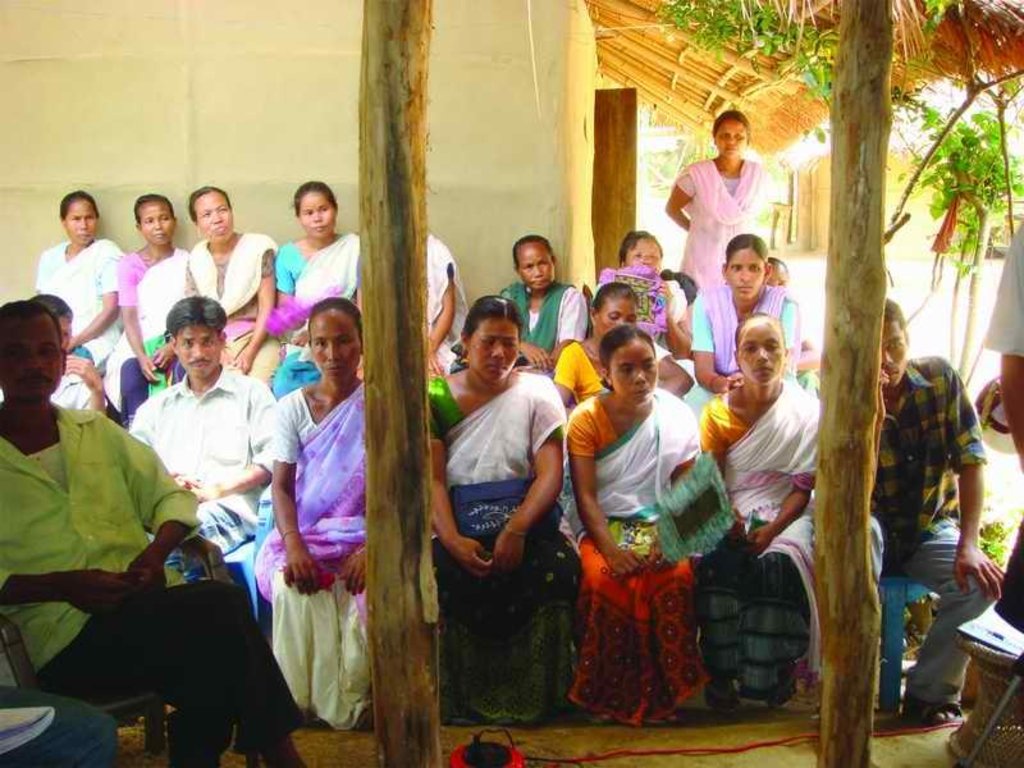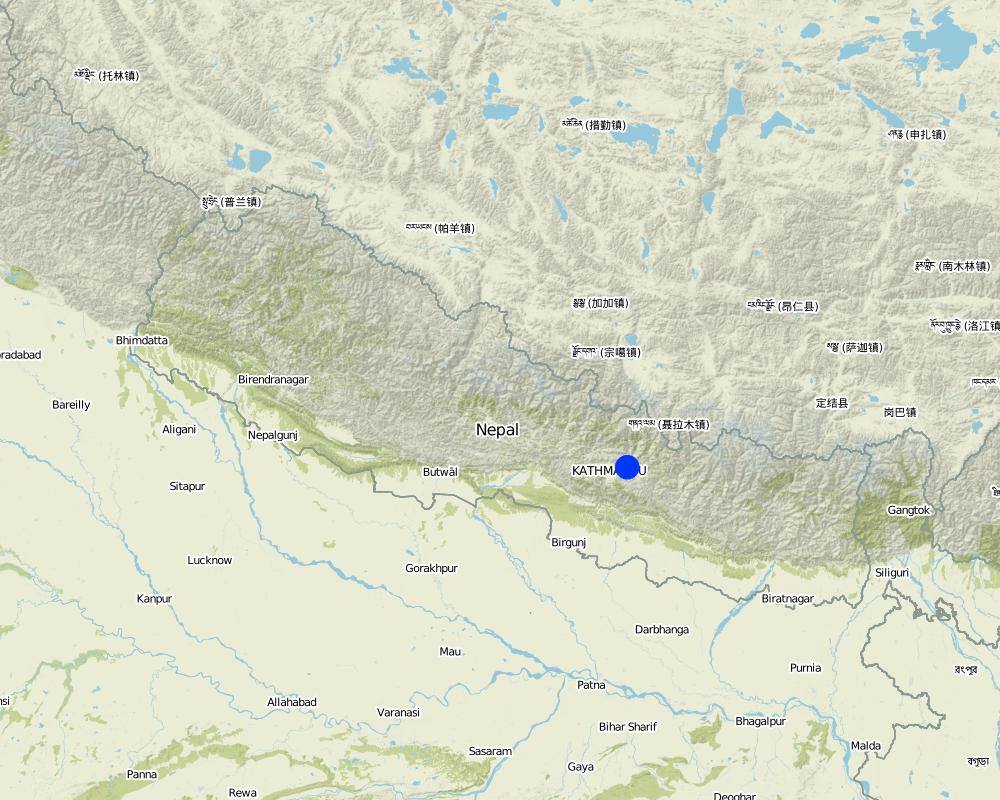Improving terraces with farmers [Nepal]
- Creation:
- Update:
- Compiler: Madhav Dhakal
- Editor: –
- Reviewer: Laura Ebneter
Kisansangai gara sudhar (Nepali)
approaches_2549 - Nepal
View sections
Expand all Collapse all1. General information
1.2 Contact details of resource persons and institutions involved in the assessment and documentation of the Approach
SLM specialist:
Name of the institution(s) which facilitated the documentation/ evaluation of the Approach (if relevant)
ICIMOD International Centre for Integrated Mountain Development (ICIMOD) - Nepal1.3 Conditions regarding the use of data documented through WOCAT
The compiler and key resource person(s) accept the conditions regarding the use of data documented through WOCAT:
Ja
2. Description of the SLM Approach
2.1 Short description of the Approach
Participatory action research with multiple stakeholders for the demonstration and extension of improved rainfed hill terraces in Nepal
2.2 Detailed description of the Approach
Detailed description of the Approach:
The traditional farming practices employed on steep sloping land in Kubinde village in Nepal's midhills led to soil and water erosion and low crop and fodder yields. The People and Resource Dynamics in Mountain Watersheds of the Hindu Kush- Himalayas Project (PARDYP) started work in 2001, with a small group of farmers from this village (who were also members of the local forest user group) and the Department of Soil Conservation and Watershed Management to identify and test an integrated approach for addressing these constraints. The approach taken was an improved hill terrace for rainfed conditions consisting of structural and vegetative measures. The aim was to demonstrate and test the technologies' potential for overcoming constraints related to farming sloping agricultural land. The specific objectives were, in association with the local farmers, to design a technology that solved soi erosion problems on sloping agricultural lands whilst at the same time increasing the land's nutrient conservation and production capacity. The local line agency office of the Department of Soil Conservation and Watershed Management was involved in developing the technology to make use of their experiences and to come up with a validated technology that the department could use in its own programmes.
Before implementing the terrace improvement work in Kubinde village, a terrace improvement committee was formed made up of local farmers. The awareness activities began in January 2001. Committee members were trained on subwatershed management and were taken to the International Centre for Integrated Mountain Development’s (ICIMOD) Demonstration and Training Centre at Godavari and another ICIMOD site to show them potential soil and water conservation technologies including improved terraces. After the technologies were implemented, a number of farmer exchange, interaction and monitoring programmes were held to assess the technology and to promote it. Indicators were developed for monitoring the activity.
About half of the costs were covered by the participating farmers and the rest by PARDYP. The other incentives were training and extension, allowances for participants, national expert honoraria, and training material such as audio-visual facilities. These were all provided by PARDYP with the help of the line agency.
2.3 Photos of the Approach
2.5 Country/ region/ locations where the Approach has been applied
Country:
Nepal
Further specification of location:
kavre Palanchok/ Kubinde village, Jhikhu Khola watershed
Map
×2.6 Dates of initiation and termination of the Approach
Year of termination (if Approach is no longer applied):
2005
2.7 Type of Approach
- project/ programme based
2.8 Main aims/ objectives of the Approach
Local farmers collectively solving problems by identifying and using the most appropriate local solutions. Local farmers designing, testing, and disseminating alternative technologies adapted to local conditions. Strengthening joint learning by farmers and development actors
The SLM Approach addressed the following problems: Weak institutional collaboration for addressing 1) poor soil fertility and land productivity; 2) soil and nutrient loss and excessive water runoff from sloping agricultural land; and 3) fodder scarcity. Lack of on-farm research for developing technologies that attend to farmers' needs.
2.9 Conditions enabling or hindering implementation of the Technology/ Technologies applied under the Approach
availability/ access to financial resources and services
- hindering
Government incentives are lacking
Treatment through the SLM Approach: The technology is cost effective.
institutional setting
- hindering
Lack of coordination among land users
Treatment through the SLM Approach: Terrace improvementuser group formed
legal framework (land tenure, land and water use rights)
- enabling
The existing land ownership, land use rights / water rights greatly helped the approach implementation: Because of private land ownership, there were no conflicts and hence the technology for deissmeination was well maintained.
knowledge about SLM, access to technical support
- hindering
It is not a priority area of line agencies
Treatment through the SLM Approach: The appraoch relies on farmer adoption
other
- hindering
lack of awareness
Treatment through the SLM Approach: Trainings , discussions and field visits
3. Participation and roles of stakeholders involved
3.1 Stakeholders involved in the Approach and their roles
- local land users/ local communities
Men and women land users worked equally
- SLM specialists/ agricultural advisers
- teachers/ school children/ students
- NGO
- local government
- national government (planners, decision-makers)
- health volunteers
3.2 Involvement of local land users/ local communities in the different phases of the Approach
| Involvement of local land users/ local communities | Specify who was involved and describe activities | |
|---|---|---|
| initiation/ motivation | passive | Group discussion; organised with local forest user group; selection of members for training and tours (12 men and 11 women); formation of terrace improvement committee. |
| planning | interactive | group discussion; survey , site selection , fodder / grass species selection |
| implementation | self-mobilization | Terracing activities: measurement, soil excavation, and retaining wall construction |
| monitoring/ evaluation | interactive | Done in a participatory way involving individual farmers, project staff, and Department of Soil Conservation staff |
| Research | passive | Assessing performance of planted grasses and advantages and disadvantages of technology |
3.3 Flow chart (if available)
3.4 Decision-making on the selection of SLM Technology/ Technologies
Specify who decided on the selection of the Technology/ Technologies to be implemented:
- mainly SLM specialists, following consultation with land users
Explain:
The package was initially offered by researchers and later modified and implemented by land users.
Decisions on the method of implementing the SLM Technology were made by mainly by land users supported by SLM specialists. The landusers are more familiar with their land's capacity and charcteristics.
4. Technical support, capacity building, and knowledge management
4.1 Capacity building/ training
Was training provided to land users/ other stakeholders?
Ja
Specify who was trained:
- land users
- extensionists/trainers, teachers, school children/students, politicians/decision makers, Health volu
Form of training:
- farmer-to-farmer
- demonstration areas
- courses
Form of training:
- Audio vidual learning
Subjects covered:
Importance of Soil and Water conservation in local level, concept of sub watershed management, activities in other parts of a country regarding SLM, etc.
4.2 Advisory service
Do land users have access to an advisory service?
Ja
Describe/ comments:
Name of method used for advisory service: Demnstration/extension of improved terrace technology;
Key elements: Participatory Action Research, Trainigs and Farmer to Farmer visits, Particpatory monitoring and evaluation; 1) Advisory service was carried out through: projects own extension structure and agents, government's existing extension system; Extension staff: project employees, govt. staff and farmers. 2) Target groups for extension: land users, technicians/SLM specialists; Activities: Farmer to farmer exchange, demonstration, trainings; Invited to trainigs, field visits
Advisory service is quite adequate to ensure the continuation of land conservation activities; Various extension service agencies have secured funding for SLM programmes.
4.3 Institution strengthening (organizational development)
Have institutions been established or strengthened through the Approach?
- no
4.4 Monitoring and evaluation
Is monitoring and evaluation part of the Approach?
Ja
Comments:
bio-physical aspects were ad hoc monitored through observations; indicators: plant heigth, biomass production, usefulness of grass/fodder species
technical aspects were ad hoc monitored by project staff through observations; indicators: views about technology
socio-cultural aspects were ad hoc monitored through observations; indicators: species selection, change of agricultural practices
economic / production aspects were ad hoc monitored through observations; indicators: changes in crop yields and patterns and the value of the land
area treated aspects were ad hoc monitored through observations; indicators: survey, on-site verifications
land users involved aspects were ad hoc monitored through observations; indicators: survey, number of land users applying for SWC
management of Approach aspects were ad hoc monitored through observations; indicators: maintenance of terraces and hedgerows
There were few changes in the Approach as a result of monitoring and evaluation: New ideas have been generated but strategies to implement them are yet to be in place.
There were few changes in the Technology as a result of monitoring and evaluation: New varieties of grass, fruit and fodder species have been introduced
4.5 Research
Was research part of the Approach?
Ja
Specify topics:
- sociology
- ecology
- technology
Give further details and indicate who did the research:
Sociology: Looking at scaling up process; Ecology: Looking at the impacts of the technology at subwatershed level; Technology: development process.
Research was carried out on-farm
5. Financing and external material support
5.1 Annual budget for the SLM component of the Approach
If precise annual budget is not known, indicate range:
- < 2,000
Comments (e.g. main sources of funding/ major donors):
Approach costs were met by the following donors: national non-government (SDC, IDRC, ICIMOD): 65.0%; local community / land user(s) (Terrace improvement committee): 35.0%
5.2 Financial/ material support provided to land users
Did land users receive financial/ material support for implementing the Technology/ Technologies?
Ja
5.3 Subsidies for specific inputs (including labour)
- agricultural
| Specify which inputs were subsidised | To which extent | Specify subsidies |
|---|---|---|
| seeds | fully financed | |
If labour by land users was a substantial input, was it:
- paid in cash
Comments:
About 50% of total labour costs were met by land users.
5.4 Credit
Was credit provided under the Approach for SLM activities?
Nee
6. Impact analysis and concluding statements
6.1 Impacts of the Approach
Did the Approach help land users to implement and maintain SLM Technologies?
- No
- Yes, little
- Yes, moderately
- Yes, greatly
Area expanded , about 100 percent of previously improved terraces was expanded. New variety of grass/ fodder species has been adopted..
Did other land users / projects adopt the Approach?
- No
- Yes, little
- Yes, moderately
- Yes, greatly
The project's aim was not to promote the approach but the technology. However, similar appraches are followed by other programs as well from before; such as the District Soil Conservation Offices.
6.2 Main motivation of land users to implement SLM
- increased production
increased production (grain and biomass) due to moisture and nutrient conervation
- increased profit(ability), improved cost-benefit-ratio
Increased land prize
- reduced workload
fodder/ grass availability ( near to house)
- aesthetic improvement
greenary throughout the season due to fodder and grass species.
- environmental consciousness, moral, health
less soil erosion from the land
6.3 Sustainability of Approach activities
Can the land users sustain what has been implemented through the Approach (without external support)?
- yes
If yes, describe how:
More than 60% of the total improved terraces in Kubinde village were built by the land users themselves. Widespread rapid adoption did not happen in other villages due to financial and labour limitations. Land users of Kubinde village continue to maintain the improved terraces.
6.4 Strengths/ advantages of the Approach
| Strengths/ advantages/ opportunities in the land user’s view |
|---|
| Technical knowledge and confidence increased from the training and field visits, interactions, and experience sharing (How to sustain/ enhance this strength: Such activities should be continued by incorporating other new ideas) |
| The approach led to the development of a team spirit among farmers (How to sustain/ enhance this strength: As above) |
| Strengths/ advantages/ opportunities in the compiler’s or other key resource person’s view |
|---|
| The approach is based on building the capacity of farmers (both men and women) by involving multiple stakeholders in the development and adoption of the technology. (How to sustain/ enhance this strength: Approach should be to strengthen land users' involvement in SWC activities) |
6.5 Weaknesses/ disadvantages of the Approach and ways of overcoming them
| Weaknesses/ disadvantages/ risks in the compiler’s or other key resource person’s view | How can they be overcome? |
|---|---|
| Due to the conflict, which was on-going at the time, follow-up after a year of implementing technology was not possible and the monitoring was not done. This resulted in the adoption of the technology by other farmers not being carried out properly with, for example, farmers not maintaining the hedgerows as recommended. Also, the new terraces were not as good as they should have been. | The technical experts need to visit the sites and identify gaps and encourage farmers to 'fill them'. For example, the benefit of hedgerow management needs to be demonstrated. |
7. References and links
7.1 Methods/ sources of information
- field visits, field surveys
- interviews with land users
7.2 References to available publications
Title, author, year, ISBN:
Mathema, P. (2003) Watershed Management in South Asia. Kathmandu: Government of Nepal, Department of Soil Conservation and Watershed Management
Available from where? Costs?
Department of soil conservation, Nepal
Links and modules
Expand all Collapse allLinks
No links
Modules
No modules






